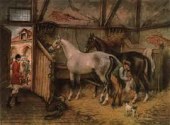More on Fiber, Protein, and possible ill effects...
SELECTING THE RIGHT HAY FOR EACH HORSE
This week we will continue our long-winded list of feeding situations with a selection of the hays that best meet the needs of our horses. In our “neck of the woods” the more common hays can be divided into legumes and the grass hays. The legumes are mostly alfalfa, but occasionally we have a client find clover hay that has been put up well. The grass hays consist primarily of fescue and orchard grass, but recently the summer grasses have been available. These are bermuda and bluestem. There are also mixtures of the legumes and grass.
The majority of us would probably consider the 2nd or 3rd cutting of alfalfa the ultimate hay. There may be some debate about this, but the quality of this hay is excellent when judged by its digestibility and nutrient content. With a little vinegar and oil, the green leaves and fine stems would complement almost any of my meals. The protein can be as high as 20% and the digestibility (which is the opposite of the fiber content) will be very high.
There is often concern about feeding alfalfa as the only forage. Rumor has it that Dobbin’s kidneys can be harmed by large amounts of legume hays. This opinion is often reached after observing the urine of a horse recently started on the hay. Instead of the yellow color and fluid consistency we normally see, the urine will be thick and off-yellow to white in color. This change is due to the high mineral content of the hay. Following digestion, the kidneys filter excess minerals from the blood and eliminate them through the urine. Urination may be frequent and in small amounts initially, but after the horse has been eating alfalfa for some time the frequency will return to normal.
The real problem with using late cutting alfalfa as the only forage is the horse’s difficulty digesting it. The combination of a very low fiber and high protein can be difficult for the horse’s intestine to tolerate. The presence of fiber slows the digestive process as the bowel must take time for digestion. Hay with a low fiber content will move through the intestine rapidly. This movement can be so rapid there is not time to form a stool. The manure can be so loose it is watery and once it dries will leave only small amounts of fiber on the ground. This may be your first clue the horse needs a different hay for the additional fiber.
If the high digestibility (and low fiber content) is not enough of a problem, a high protein hay can actually cause the lining of the intestine to become inflamed. When seen on post mortem examination, the folds will be reddened and swollen. As a result, the horse’s natural response is to try to eliminate the source of the protein, which has now become an irritant. The bowels will become hyperactive in an attempt to move the hay on through as rapidly as possible. The resulting diarrhea will both dehydrate the horse and be toxic as well. The toxic effects of protein cause a fever which further dehydrates the patient. The combination of diarrhea, dehydration, and the toxic reaction can be deadly. If we do not meet the horse’s fluid needs and neutralize the toxic reaction, the horse can die within 24 hours.
We treat a few of these cases each year. They usually occur when the grass has finally deteriorated to the point there is no other roughage available. We may also see these cases when one hay supply has run out. As a result of either of these situations, new hay is brought in and given to the horse as the only roughage. If this new hay is the high quality, highly digestible, high protein second-or-later cutting of alfalfa, within hours the horse will be showing signs of what is certainly an emergency situation.
CLICK BELOW TO DISPLAY A PRINTER-FRIENDLY COPY OF THIS ARTICLE
Select "Open this file from its current location," if you just want to print it out,
it will open in a simple word processing application, select the print button.
(unless you want to save this article in your computer's memory)

 TheRightHayForEachHorse.rtf
TheRightHayForEachHorse.rtf